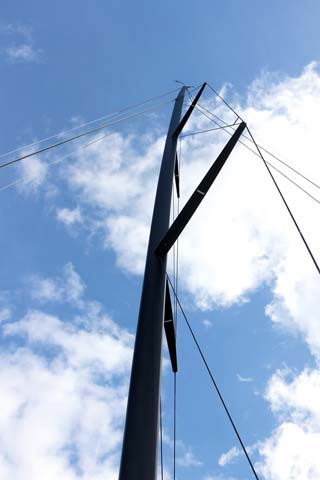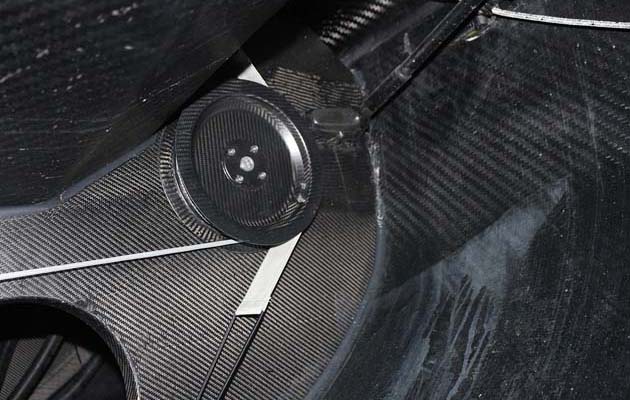Rupert Holmes takes a closer look at Peter Morton’s Carkeek 40 Girls on Film – an object lesson in how to get an edge and hold it consistently in a race series.
The Carkeek 40 is a proven design that originally dates from 2012. Girls on Film, winner of four of the five class events this year to take the overall Fast40+ season title, is a Mark 3 version, and benefits from numerous small modifications. While many of these offer a saving of only a few seconds in certain conditions, in a fleet that’s renowned for incredibly close racing – the podium is routinely filled by boats less than 60 seconds apart – the collective effect of these makes a big difference to series results.
When specifying the boat, Peter Morton took some key decisions at an early stage. He went for the maximum hull length allowed by the class, the upper IRC rating limit of 1.270, the deepest draught allowable of 3.0m and the minimum weight allowable within the rating limit.
The Fast40+ fleet competed for the famous One Ton Cup for its 2016 national championship, the first time the trophy has been awarded since 1999
The project started with a 12.2m (40ft) hull and deck that became available following a cancelled order, so an extra section was grafted onto the transom to take the hull length up to 12.6m (41ft 4in), the maximum allowed for new boats. This has been carefully styled – it’s impossible to tell that it has been modified. As well as increasing the effective waterline length this also allows crew weight to be moved further aft.
Once all systems, including the rig, had been pared down as light as possible the keel bulb was milled over the course of 24 hours to hone it to exactly the right shape and weight to meet the target displacement. The bulb was designed from the outset to be bolted onto the fin in different positions and was moved aft mid-season, which created a useful increase in speed.
The original carbon mast was a two-piece section designed to make containerised transport easier and weighed 240kg, including the rod rigging. Changing to an ultra-high modulus spar of much smaller section, along with Future Fibres’s ECsix carbon standing rigging, has reduced that weight by one-third. This has improved stability – like sailing without an extra crew member perched on the second spreaders – yet boat captain Nick Butt reckons the spar is the stiffest in the fleet.
The deck layout is very similar to that of current TP52s, with systems optimised to be as light and friction-free as possible, plus a number of clever innovations. Butt describes the deflector system used to limit mast bend as a “work of art” that’s much neater than conventional hydraulic arrangements. The line winds onto a spindle at the base of the rig, giving a 30:1 advantage, while there’s a ‘suck away’ system that tidies the excess line onto another spool below deck. It’s effective and all but eliminates the possibility of a line snagging. A similar system tidies spinnaker sheets.
The custom traveller has a double ‘magic wheel’ system that straddles the aft bulkhead on each side of the boat. The bearing carriers are built into the bulkhead, with wheels of different sizes ahead and abaft providing the system’s mechanical advantage. It’s lighter than a block and tackle system, yet has much less friction.
Controlling jib shape
There’s full three-dimensional control over the jib sheeting system, with everything controlled by under-deck block and tackle systems. There are three of these on each side: one for the transverse jib car position, one for the friction ring that runs through the car to determine the fore-and-aft position of the sheet lead, and one for the outboard sheet lead (a 2:1 tackle to pull the sheet out to the sheer). In addition, there’s a tack cunningham as the halyard is on a lock and is therefore not adjustable. On white sail reaches a reaching strut can be set to leeward, moving the sheeting position around 700mm outboard. This maintains the sail’s optimum twist when sailing at greater apparent wind angles.

Photo Paul Wyeth
In common with other contemporary grand prix boats configured for inshore racing, all Fast40+ designs are seriously wet inside and out. This is due to the plethora of lines that pass through the deck and the big forehatch used for launching and recovering spinnakers. “These boats are inherently soaking wet – it’s like a swamp,” says Butt.
Controlling water ingress was, therefore, a high priority, and Girls on Film has a system of self-draining wet boxes that divert as much water as possible overboard, as well as five automatic bilge pumps. Even so, Butt feels that an extra two or three pumps would make a useful difference. Taking no chances with water ingress, the boat computer is in a fully waterproof Peli case, with a wireless link to an iPad Mini used by the navigator on deck.
Of the 14 Fast40+ designs competing in 2016, 11 scored podium finishes
Batteries are another area that offered significant potential for weight savings. The three lithium-ion units are around 20kg lighter than the equivalent lead-acid batteries would be and can be discharged repeatedly to a very low level. They take up very little room, yet have enough capacity to power the five pumps, instrument system and boat’s computer during racing.
Specifications: Girls on Film optimised Carkeek 40 MkIII
Hull length: 12.60m (41ft 4in)
Beam: 3.85m (12ft 7in
)
Draught: 3.00m (9ft 10in)
Displacement: 3,850kg (8,490lb)
Upwind sail area: 109.1sq m (1,173sq ft)
Downwind sail area: 249sq m (2,680sq ft)

Girls on Film, Carkeek 40:The deck layout broadly follows that which has been well proven by TP52 teams, but includes a number of innovations to minimise weight and friction. Photo Paul Wyeth.

The scoop added to the stern of the boat stretched it to the maximum hull length under the Fast40+ class rules for new boats.

The reaching strut moves the headsail sheeting position outboard, allowing full control of twist on a white-sail reach.

The small-section ultra-high modulus spar mast, along with ECsix carbon standing rigging, saved 80kg of weight aloft.

The spool at the mast base provides purchase for the deflector line.

The ‘suck away’ system for the deflector line. This spool tidies up to 30m of line in moments.

Below deck purchase systems for the jib car, sheet lead, outboard sheet and tack cunningham.

The custom ‘magic wheel’ traveller system straddles the aft bulkhead below decks, with the bearing embedded in the bulkhead.

The pen in the image provides a visual clue as to how tiny these lithium-ion batteries are, yet they provide ample power for a day’s racing.




